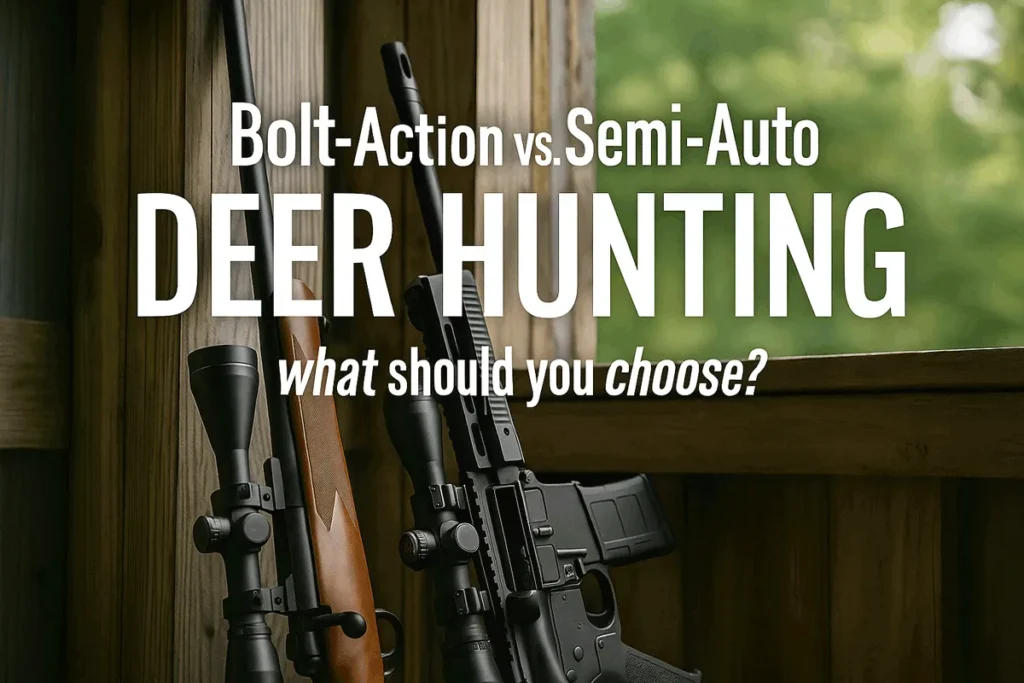Bolt-Action vs. Semi-Auto Rifle: Which Should You Take Deer Hunting in 2025?
August 19, 2025

If you prioritize first-round precision, light weight, and simple upkeep, a bolt-action rifle is still the easy button. If you value softer recoil, faster follow-up shots, and modern ergonomics, today’s semi-auto rifles are better than ever. Either way, buy quality glass and good ammo—your groups will thank you.
With fall tags on the horizon, many hunters are weighing the same question on August 19, 2025: bolt-action or semi-auto? Below we break down what’s changed, how each platform fits typical North American deer hunts, and which specs actually matter in the field. One quick joke before we get serious: the “best rifle” is the one that’s zeroed—preferably by you.
The Trend
In the last couple of seasons, the lines between classic hunting rifles and “modern sporting” setups blurred. Bolt guns now ship with features that used to be custom-only—threaded muzzles, adjustable stocks, and integral optics rails—while semi-autos have leaned into hunting-friendly trims with lighter profiles, tuned gas systems, and cold-hammer-forged barrels. Mid-price offerings from brands like Savage, Ruger, Remington, and Browning make it easier than ever to pick a capable deer rifle without spending custom money.
Spec Highlights & Standouts
- Practical accuracy: Many factory bolt-actions are built to deliver ~1 MOA with quality ammo, thanks to improved barrels, bedding systems, and crisp triggers. In real deer woods, that translates to high confidence on 100–300 yard shots.
- Recoil & shot cadence: Gas-operated semi-autos tame recoil impulse and keep the reticle flatter, which can help with fast, ethical follow-up shots if your opportunity window is brief.
- Weight & balance: Typical hunting bolts run 6.0–7.5 lbs bare; semi-autos often start near 7.5–8.5 lbs. Add a scope and sling and you feel it on steep hikes; lighter rigs matter if you still-hunt or climb into higher elevations.
- Capacity & controls: A 3–5-round internal or detachable mag is common on bolts; 5–10+ on semi-autos. Semi-autos also bring ambi controls and AR-style ergonomics that fit a broad range of shooters with minimal stock work.
- Maintenance & reliability: Bolts are famously tolerant of neglect and grit. Modern semi-autos run extremely well when properly gassed and lubricated, but they do ask for a little more attention—especially after wet or dusty days.
Comparisons
Below are four representative approaches hunters consider in 2025. We’ve linked to brand pages as a starting point; model-specific pages will be added to the GunGenius catalog as needed.
- Ruger “American-style” bolt: value-driven accuracy, simple bedding, light to carry; ideal for whitetail in mixed timber where shots are 50–200 yards.
- Savage “110/Axis-style” bolt: adjustable triggers/stocks and a reputation for groups that embarrass rifles twice the price.
- Remington “700-pattern” bolt: deep aftermarket for stocks, triggers, and barrels if you like to tinker into a semi-custom down the road.
- Browning BAR-style semi-auto: reduces felt recoil and speeds a second shot on moving deer; slightly heavier but confidence-inspiring in big woods.
If you prefer platform-agnostic browsing, start with all rifles, then filter by bolt-action or semi-auto and your preferred caliber (e.g., .308 Win, 6.5 Creedmoor, .243 Win).
Use-Case Playbook
Eastern hardwoods (thick cover, 50–150 yards): A compact bolt in .308 Win or .350 Legend is hard to beat: quick to shoulder, inherently quiet to cycle, and easy to keep light. Add a 1–6x LPVO or a 2–8x and you’re set.
Open country (150–400 yards): If you’re prone to crosswinds and longer shots, a bolt with a heavier contour barrel and a quality 3–15x scope maximizes first-shot confidence. 6.5 Creedmoor remains a popular pick for its balance of recoil and ballistics.
Moving targets or short shot windows: A well-tuned semi-auto shines here, especially for hunters who practice quick second shots under 150 yards. Gas systems soak up recoil and help you keep eyes on target between shots.
New or recoil-sensitive shooters: Semi-autos reduce flinch and fatigue over a long practice day. Pair with a lighter cartridge and a suppressor (where legal) for very manageable recoil.
Harsh weather & hard use: If you’re slogging through rain, ice, or sand, a stainless/cerakoted bolt with a simple stock is a proven recipe. Fewer moving parts means less to foul when Mother Nature gets cranky.
Features That Actually Matter
- Barrel & crown: A quality barrel with a clean crown matters more than a fancy stock. Threaded muzzles let you add brakes or suppressors (where legal) and don’t hurt resale.
- Trigger you can run: Sub-3 lb isn’t necessary for hunting, but a crisp, consistent break you trust absolutely is. Many modern bolts ship with adjustable triggers; semi-autos have excellent drop-in options.
- Stock fit: Adjustable comb/length of pull improves eye alignment and comfort. If your cheek weld is off, accuracy suffers regardless of platform.
- Scope mounting: Make sure your receiver is properly drilled/tapped (bolts) or that your upper has a reliable Picatinny rail (semi-autos). Use proven rings/bases; cheap hardware causes expensive misses.
- Magazines: For bolts, AICS-pattern mags are ubiquitous and easy to source. For semi-autos, stick to trusted brands to avoid feed issues once the weather turns cold.
Cost Breakdown (2025 Reality Check)
Entry-level hunting bolts often start well under the price of a comparable semi-auto and leave more budget for glass and ammo. Semi-autos typically carry a premium for receivers, gas parts, and compliancy testing. Either way, the smartest spend is a reliable optic, quality mounts, and a few boxes of the exact load you intend to hunt with—then confirm your zero and dope at realistic distances.
What to Watch Next
Expect more factory-threaded barrels, suppressor-ready SKUs, and lighter stocks from mainstream brands as we head toward peak season. Also watch for “hunter-tuned” semi-autos with adjustable gas blocks and lighter furniture, narrowing the weight gap with traditional bolts. Keep an eye on Ruger, Savage, and Browning product pages for incremental mid-season trims—sometimes the best value appears right before the leaves turn.
Browse related models on Rifles (all).